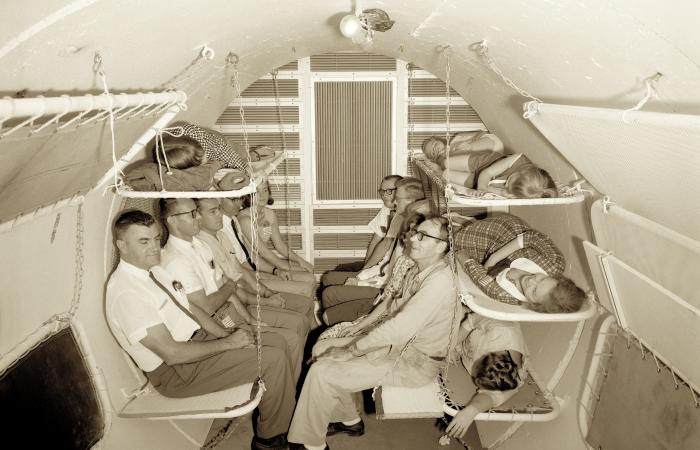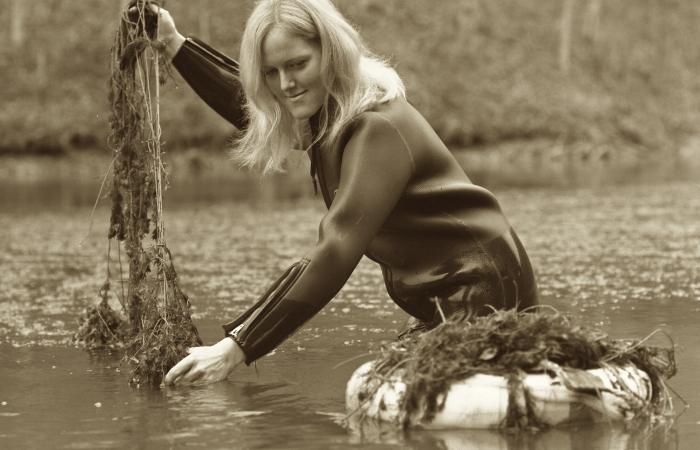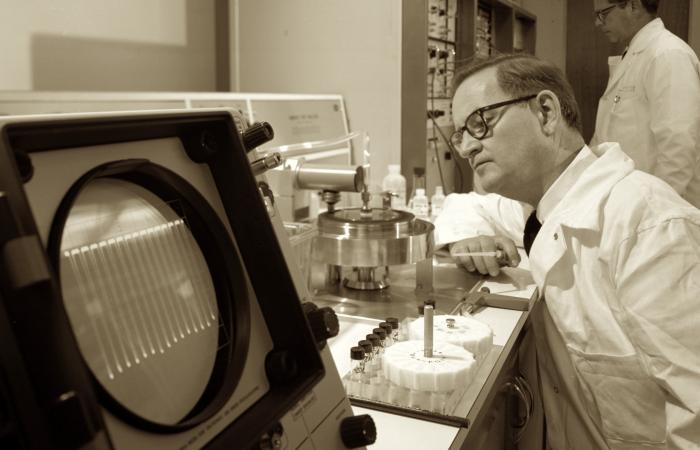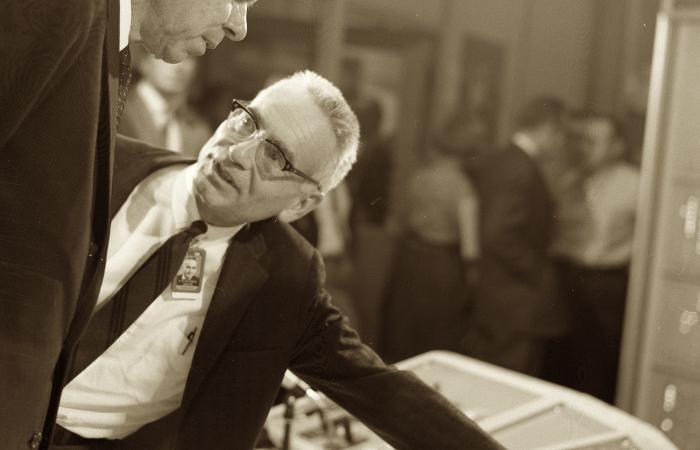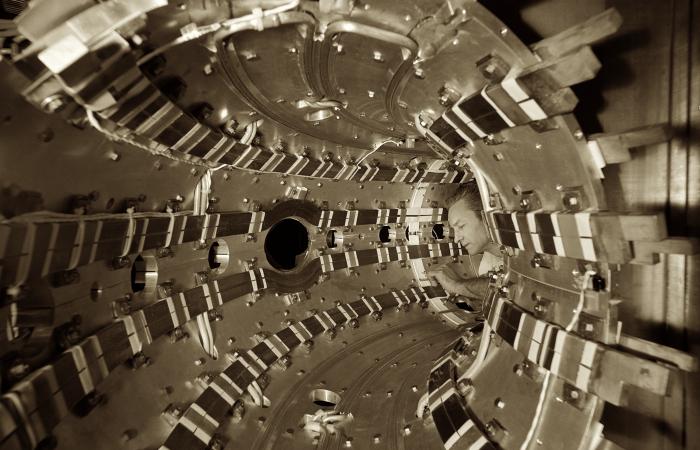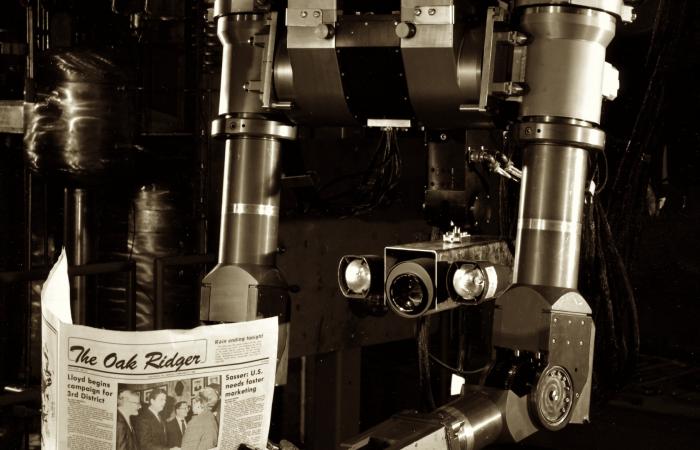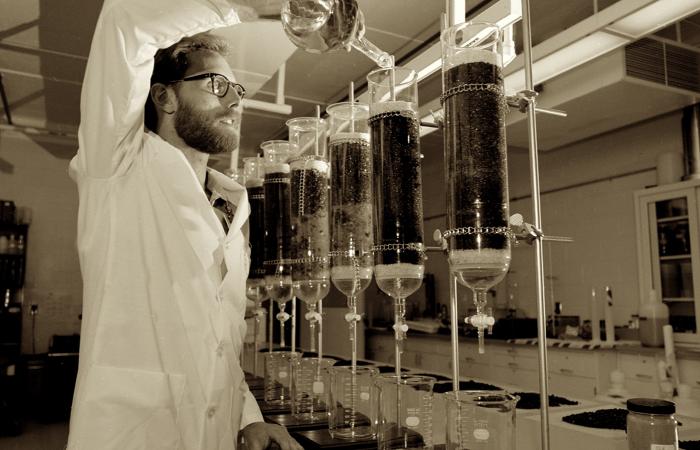75 years of science and technology
While ORNL researchers produced isotopes for medicine, designed and tested nuclear power reactors, and studied the biological effects of radiation, the advent of nuclear weapons transformed global politics.
During the four-decade Cold War, new feats of science and technology fed threats and fears, while outside the political theater, discoveries in biology, nuclear physics, materials science and more transformed daily lives.
The Cold War and the space race
In 1957, the Soviet Union launched the first artificial satellite, Sputnik, and the “space race” began. Four years later, American President John F. Kennedy challenged the nation to be the first to put a man on the moon—a feat he said would demand “a major national commitment of scientific and technical manpower.”
That technical manpower included ORNL. When Apollo 11 landed on the lunar surface in 1969, the crew carried Oak Ridge-designed scoops and a vacuum-sealed box for collecting moon rocks. When the crew returned safely to Earth, fulfilling President Kennedy’s moonshot vision, some of the lunar samples came to the lab for analysis; they were assayed for uranium, thorium and other indicators of their age.
To protect astronauts from damaging radiation in space, ORNL researchers repurposed the Tower Shielding Facility from the canceled nuclear aircraft project and used it to develop lightweight shields for the Apollo crews. Lab biologists sent blood samples on satellites to study the biological effects of space travel, and physicists used the fast-burst Health Physics Research Reactor to determine the radiation dose an astronaut’s internal organs might receive.
Once man reached the moon, NASA wanted to go farther— through the solar system via unmanned probes that would require decades of power. ORNL contributed to research that evaluated possible nuclear generators. When NASA chose a radioisotope generator of plutonium-238 oxide fuel, the lab designed a high-temperature, corrosion-resistant iridium alloy cladding that secured the radioactive fuel and a carbon fiber insulation that maintained the cladding’s temperature. The ORNL technology was used in the Voyager 1 and 2 probes that launched in 1977 and transmitted the first images of Jupiter’s ring system and Saturn’s moons. Today, the iridium-based cladding and other Voyager components drift farther than any other humanmade material, as Voyager 1 has crossed into interstellar space.
Civil defense and the arms race
Although the Cold War space race captured America’s imagination, the Cold War nuclear arms race incited new fears. The Cuban Missile Crisis in 1962 ended peacefully but led the American people, including the nation’s scientists, to ask, “What if?”
Former research director Eugene Wigner returned to ORNL for a year in 1964 to organize and lead a civil defense project that evaluated how Americans could prepare themselves for a nuclear attack. The project looked at the technical, political, military and social aspects of defense.
The lab hired its first social scientists to study how people respond to stress. The project’s engineering challenges included designing protective underground tunnels with power and ventilation, shelter from chemical hazards, and radiation shielding for livestock. Lab scientists simulated radioactive fallout and studied the possible effects of “nuclear winter”—the prolonged, cloudy darkness created by spreading fires.
Fortunately, the Cold War ended without the use of nuclear weapons. Even so, some of the civil defense strategies developed at ORNL have been applied in the years since to natural disasters and other emergencies.
Technology for public health
By the late 1960s, ORNL’s Biology Division was at its largest, with more than 400 employees. The Health Physics Division was studying nuclear energy's impact on health and the environment. New technologies were also developed and applied to the fundamental study and betterment of human health.
Centrifuges developed to separate isotopes inspired technology to purify vaccines by removing foreign proteins. This ORNL technology was used to produce safer vaccines for millions of people. In 1972, lab cryobiologists developed a method of freezing mouse embryos, then implanting them into female mice that gave birth to healthy mouse pups. This technique was used in the cattle industry to increase the quantity and quality of meat for a growing population and eventually was used to preserve human organs for transplants.
A defining health issue of the 1960s and ’70s was the relationship between smoking and cancer. Mounting evidence suggested that cigarettes increased the risk of lung cancer, and the National Cancer Institute, American Cancer Society and tobacco industry funded different laboratory smoking studies, including research to find less hazardous ingredients for cigarettes.
As part of this effort, ORNL built “smoking machines” that burned standardized cigarettes to produce usable quantities of tar to identify chemicals responsible for cancer and other adverse health effects. Lab researchers also exposed animals to cigarette smoke and other irritants, such as smog and pesticides, to understand additional contributors to lung cancer.
The environmental movement
Beginning after World War II and escalating during the 1950s and ’60s, environmental issues became a central topic of debate, public protest and policymaking in the United States. Pesticides, smog, oil spills, and nuclear safety and waste disposal emerged as national social and scientific conversations. Legislation addressing water and air pollution gave the government the right to regulate pollutants and led to government, nonprofit and citizen protective efforts.
The first photo of Earth, taken by Apollo astronauts in 1968, became a symbol for the first Earth Day on April 22, 1970, in which 20 million people demonstrated across the country on environmental issues. That same year, President Richard Nixon created the National Resources Defense Council, the Environmental Protection Agency and the National Oceanic and Atmospheric Administration. The federal environmental shakeup also affected the future of ORNL, which once considered itself primarily a nuclear laboratory.
As part of the National Environmental Policy Act that created the EPA, federal agencies were newly required to provide environmental impact assessments detailing how the agency’s actions might affect the environment. In 1971, a federal court ruled that the Atomic Energy Commission had to provide environmental impact assessments in just a year’s time for about 90 nuclear power plants either operating or underway. The AEC turned to its national laboratories, including ORNL, which had built a reputation for radiation and nuclear safety expertise. About 200 staff members at the lab worked on the assessments, which stimulated innovative research in areas ranging from sensor development to energy demand forecasting.
In 1973, an oil embargo by the Organization of the Petroleum Exporting Countries led to an energy crisis, with Americans lining up at the pumps for gas and turning down the heat in their homes and offices. At the same time, ORNL faced not only an energy crisis but a change in leadership: Longtime lab director and nuclear pioneer Alvin Weinberg left his position after 18 years.
One year later, the AEC was abolished by the Energy Reorganization Act of 1974, which created two new agencies to handle energy matters: the Energy Research and Development Administration to manage the AEC’s programs in energy research and development, nuclear weapons, and naval reactors, and the Nuclear Regulatory Commission to regulate the nation’s new fleet of nuclear power plants.
The lab adapted its nuclear roots to study a range of energy sources and applications. With this change came a new lab director, Herman Postma, a fusion (rather than a fission) scientist and the first lab director who did not have Manhattan Project experience.
The lab mirrored the creation of ERDA with creation of its own Energy Division for energy and conservation research. By 1977, President Jimmy Carter elevated energy research to an executive department and established the Department of Energy, which today manages 17 national laboratories, including ORNL.
During the energy crisis, public and scientific opinion identified two overarching solutions: first, increase U.S. energy independence through the creation of new energy sources, and second, reduce energy consumption.
New sources of energy
In light of rising environmental concerns and the energy crisis, scientists began exploring energy sources beyond nuclear fission and petroleum energy. For fuels, they looked in the 1970s and ’80s primarily to coal liquefaction, as coal was an abundant American resource. For electricity, they looked to solar, wind and geothermal energy. Research also continued into nuclear fusion, which promised to provide limitless energy if only the technology could be developed to support it.
Alternative fuels
Until the mid-20th century, when U.S. petroleum consumption spiked, the United States relied largely on coal power. Because coal was plentiful, researchers looked for ways to turn it into liquid fuel to supplement imported petroleum. Using chemical processes, scientists could convert it to liquid or gas to create a synthetic fuel. Increased coal research led to fundamental studies of the structure and properties of coal. Related ORNL research revealed that the chemicals produced during the conversion of coal to liquid or gas at that time could lead to adverse health effects.
Much of ORNL’s work for DOE's fossil energy program was materials related. ORNL worked with industry to modify an existing steel alloy for use in advanced breeder reactors and to qualify the new alloy, known as Grade 91 steel, for commercial use in fossil energy applications. ORNL has also developed other alloys for ultrasupercritical steam power plants and other high-temperature applications, plus ceramic membranes, carbon fiber composite molecular sieves, and corrosion-resistant coatings to increase the efficiency of fossil energy systems.
In the 1970s and ’80s, ORNL environmental scientists who had been studying plant and aquatic life to evaluate the impacts of nuclear energy also began studying how they could produce fuel from plants. Researchers helped identify two promising feedstocks for converting wood to fuel—poplar and switchgrass. ORNL led a study for DOE that produced its first “Billion-Ton” report in 2005, projecting that the United States has the potential to produce a billon tons of biomass annually by 2040. Later, ORNL researchers helped tackle bioenergy’s stubborn problem of recalcitrance, or the resistance of the plant cell wall to breaking down and releasing energy. To support targeted research on bioenergy breakdown and processing, DOE established a multi-institutional BioEnergy Science Center led by ORNL in 2007.
Solar and geothermal
The idea of solar energy is nothing new. Early studies of the photovoltaic effect to convert sunlight into energy date to the 19th century. By the 1950s, several technology companies were developing their own silicon photovoltaic cells. The challenge for the national laboratories was to determine how to make solar energy production economical.
At ORNL, researchers tapped into their background and experimented with the use of solar energy to heat liquid sodium and molten salts to generate electricity, but the technique proved too expensive. Then they turned to the task of making silicon solar cells more efficient and used the Bulk Shielding Reactor to develop a new method for modifying silicon’s semiconducting properties. The method—neutron transmutation doping—uniformly distributed phosphorus ions in the silicon, increasing efficiency. Researchers also improved the efficiency of heat exchangers that produced electricity using geothermal energy from hot water and steam trapped in the ground.
Fusion
Although it took only four years from the discovery of nuclear fission to build the first operating fission reactor, harnessing nuclear fusion—producing energy by combining or “fusing” the nuclei of light atoms, rather than by splitting heavy atoms— proved more elusive. Building a reactor that creates more energy than it uses turned out to be an enormous technical challenge, and the hot plasma in a fusion reaction was the hottest medium ever handled, requiring new heat-resistant materials.
ORNL had begun exploring fusion energy in the 1950s and constructed a series of experimental devices to test various ways to contain a fusion plasma using powerful magnetic fields. In 1968, the Soviet Union built the world’s first tokamak, a promising configuration that confines the fusion plasma in a doughnut-shaped, or toroidal, vacuum vessel, and the United States soon set out to build its own. In 1971, the Oak Ridge Tokamak, or ORMAK, Oak Ridge’s first experimental tokamak,
reached a plasma temperature of 20 million kelvin (about 35 million degrees Fahrenheit). A thin, but vacuum-tight, stainless steel liner, gold plated to minimize impurities, surrounded the ORMAK plasma. This liner was enclosed in a cooled aluminum shell. ORMAK demonstrated the feasibility of heating a fusion plasma by injection of energetic neutral particles. Neutral beam injectors are now standard equipment on all magnetic confinement devices.
The lab constructed a slightly larger tokamak, the Impurity Study Experiment, that began operating in 1977. Also in 1977, ORNL embarked on construction of the International Fusion Superconducting Magnet Test Facility, or IFSMTF. Using conventional copper electromagnets to create the strong magnetic fields needed to confine a fusion plasma requires enormous amounts of electrical power, but magnets made of superconducting materials, in which electrical resistance vanishes at low temperatures, offer a solution to this challenge.
The IFSMTF was used to test six 20-foot magnets—three built by the United States and three by international partners Japan, Switzerland and the European Atomic Energy Community—that were supercooled using liquid helium at a temperature of 4.2 kelvin, or roughly minus 452 degrees Fahrenheit. Another enduring ORNL contribution to fusion energy was the development of hydrogen pellet injection, a technique in which frozen pellets of neon, argon, or hydrogen are injected into the plasma to add fuel or control plasma instabilities.
As the energy crisis eased in the 1980s, funding for the U.S. fusion program declined. ORNL's last large-scale fusion experiment was a stellarator called the Advanced Toroidal Facility, which operated from 1987 to 1994. ORNL remained actively involved in fusion research and currently manages the American contributions to ITER for DOE’s Office of Science. ITER, which will be eight times larger than the biggest current tokamak, is considered the next major step for fusion energy development. The international project is a collaboration among the United States, the European Union, the People’s Republic of China, India, Japan, the Republic of Korea and the Russian Federation.
Construction is advancing on the ITER tokamak complex in France, while components are in fabrication by the ITER partners around the globe. Among the components being supplied by the United States are superconducting magnets and a pellet injection system.
ORNL also continues to develop materials to withstand the extreme fusion environment, conducting irradiation experiments in HFIR and operating the Prototype Materials–Plasma Exposure Experiment, or Proto-MPEX. MPEX, which will soon succeed Proto-MPEX, will develop materials for devices beyond ITER, including the first generation of experimental fusion power reactors.
Energy efficiency
Buildings still consume most of the energy produced in the United States, but they have come a long way in terms of efficiency. In the 1970s, researchers identified insufficient insulation and inefficient heating and cooling systems as home energy sinks.
After analyzing data from an instrumented mobile home, ORNL researchers recommended tighter insulation and storm windows to reduce the leaking of hot and cold air—a standard that improved the design of manufactured homes. By the end of the 1980s, ORNL recommendations for insulation thickness, or R-values, were widely adopted across the country.
Following a tip from a lab retiree, ORNL researchers developed a heat pump connected to an underground water tank that used stored water to heat and cool a home. By partnering with the University of Tennessee in 1976 to build a demonstration home with this Annual Cycle Energy System, researchers observed that the system could cut home heating and cooling costs by as much as half. Later, the lab developed a new design for a geothermal heat pump that used an ecofriendly heat-exchange fluid to reduce electrical use in retrofitted homes by more than 30 percent.
Although there were big gains to be made in improving insulation and heating and cooling systems, the impact wouldn’t be significant until homeowners and businesses replaced those systems over time. To start reducing household energy consumption in the short run, researchers looked to appliances such as refrigerators, water heaters and furnaces, which are replaced more frequently. Through partnerships with industry, many ORNL innovations have entered the marketplace.
As computer workstations became more common and powerful at the lab, scientists developed computer models to analyze and optimize the energy efficiency of home appliances. By the 1980s, ORNL estimated that most American homes had at least one appliance that was more energy efficient because of ORNL research. In the 1990s, researchers also developed more environmentally friendly and energy-efficient refrigerant blends that did not contain chlorofluorocarbons, which damaged the ozone layer.
In 1987, ORNL built a Roof Research Center that allowed researchers to install instrumented roof panels and collect data for computer models on how heat traveled through roofing structures. The center included a climate simulator that allowed researchers and industry users to examine roofing systems in different weather conditions—work that continues to this day at the Building Technologies Research and Integration Center. In 1999, the EPA released its first Energy Star whole-building-performance energy-rating tool based on the benchmarking methods developed at ORNL.
With significant energy efficiency improvements in home construction and appliances, DOE set a goal for the 21st century of combining insulation, energy-efficient appliances and solar cells to design “zero energy” homes that collect and generate as much energy as they use.
Nuclear safety
In 1979, at the end of an inventive decade of energy conservation research at ORNL, nuclear power and safety came back to the forefront when news broke of a reactor failure at the Three Mile Island nuclear power plant in Pennsylvania.
A mechanical or electrical failure led to an automatic shutdown of the plant's Unit 2 reactor. Then, a pressure valve that was supposed to close as reactor core pressure dropped remained open, even though instruments in the control room indicated it was closed. With no cooling, the reactor core overheated and partially melted down. Although radiation was contained and not released into the environment, the Three Mile Island accident was considered the worst nuclear accident in U.S. history and came at a time when environmentalists were already questioning the safety of nuclear power.
During the 1960s and ’70s, ORNL’s reactor physicists and engineers had increasingly focused on safety-related projects. The lab built a nuclear safety pilot plant for studying fission product behavior under accident conditions and a heat-transfer facility for testing fuel elements. Researchers designed stable containers for shipping radioactive materials, simulated the impact of earthquakes on reactor stability, and developed more sophisticated robotic servomanipulators (robotic arms and hands) for safely handling materials in radioactive environments. The lab also designed and built a high-sensitivity isotope ratio mass spectrometer in 1976 to measure nuclear samples from around the world and ensure compliance with the Treaty on the Nonproliferation of Nuclear Weapons.
ORNL’s nuclear reactor and safety experts were deployed to the Three Mile Island plant as onsite analysts. They monitored radiation emissions after the accident and added chemicals and filters that helped prevent radioactive releases. ORNL experts also analyzed and removed fission products from contaminated water stored at the site.
Seven years later, ORNL researchers investigated a far more serious nuclear accident: the Chernobyl disaster in the Soviet Union. After the accident, U.S. researchers modeled the Chernobyl reactor and determined that the operators did not fully understand the system.
In response to the two accidents, DOE shut down many of its reactors, including ORNL’s Bulk Shielding, Health Physics Research, High Flux Isotope, Oak Ridge Research and Tower Shielding reactors, for stringent safety evaluations. Only two of the five reactors were brought back on line: HFIR, because of its critical role in producing isotopes, and the Tower Shielding Facility, which was not permanently shut down until 1992.
A national resource
With the dissolution of the Soviet Union in 1991, Cold War tensions gave way to a booming international marketplace, spurred by rapid developments in materials and technology, particularly communication. The presidential administration of George H.W. Bush was interested in strengthening U.S. economic competitiveness through science and technology while creating new international partnerships to share knowledge and ideas.
At ORNL, new user facilities welcomed thousands of scientists each year from universities and industry to use the lab’s unique, state-of-the-art resources. Cooperative Research and Development Agreements, a product of the Superconductivity Pilot Centers established by DOE in 1988 to accelerate development and commercialization of newly discovered high-temperature superconducting materials, enabled companies to collaborate with the lab and license lab inventions to bring new technologies to the marketplace faster. Once renowned primarily as a nuclear science and engineering laboratory, ORNL had become a national and global resource for energy-related research and development.
Accelerating physics
Underlying all matter—whether fissile uranium, semiconducting silicon or organic carbon—are complex nuclei. The tools created for the Manhattan Project offered scientists the opportunity to learn more about the fundamentals of nuclear structure and reactions. Drawing on their recently acquired expertise in electromagnetic separation of isotopes, ORNL researchers started building cyclotrons and using them not only to produce new isotopes but also to understand the processes involved in the formation and motion of ions in electric and magnetic fields. In 1962, one of the world’s first strong-focusing accelerators, the Oak Ridge Isochronous Cyclotron, began producing ions for research. The existence of the giant quadrupole resonance— a collective vibration of nuclei important to quantum physics studies—was confirmed at ORIC in 1972.
Shortly after the ring-shaped cyclotron was built, the lab added the Oak Ridge Electron Linear Accelerator. Located 20 feet below ground, ORELA provided short-pulse neutrons at an intensity about 10 times that of any other linear accelerator in the world, enabling neutron cross-section measurements for nuclear criticality safety, nuclear reactor and fuel cycle analysis, stockpile stewardship, weapons research, medical diagnosis, and nuclear astrophysics. Several experiment stations for physics research were located at the ends of neutron beam flight tubes extending radially from the ORELA target room.
In 1980, the lab added a 25-million-volt tandem accelerator to the ORIC facility, creating the Holifield Heavy Ion Research Facility, which was again upgraded in 1997 as the Holifield Radioactive Ion Beam Facility to support production of short-lived radioactive isotopes. During the facility’s five decades of operation, beginning with ORIC, ORNL was able to provide researchers from around the world with 70 ion species and 200 rare isotopes for unprecedented nuclear and astrophysics research.
Microscopy
Advances in microscopes enabled new discoveries in biology and materials. Sophisticated electron microscopes allowed researchers to peer inside the cell and observe and image proteins and DNA. In 1967, a high-powered experimental microscope allowed ORNL researchers to observe genes making RNA in frog eggs. Using an electron microscope in 1974, researchers discovered the nucleosome, which revealed how DNA is wrapped and packaged into chromosomes in the cell nucleus.
New imaging techniques also improved the study of materials, contributing to the lab’s development of strengthened steel alloys and heat-resistant ceramics. In the early 1970s, transmission electron microscopy was used to study radiation damage in metallic structural alloys for breeder and fusion reactor applications. Other microanalytical tools followed, and in 1977, ORNL created the Shared Research Equipment User Facility, sponsored by DOE’s Basic Energy Sciences program, to provide access to its state-of-the-art resources for examining metallic, ceramic and other structural materials. In 1987, ORNL opened the High-Temperature Materials Laboratory user facility with cutting-edge microscopes and laboratories for solving materials problems limiting the efficiency and reliability of advanced energy conversion systems. Industry and university collaborations at HTML led to new and improved materials for electronics, superconducting magnets, energy-efficient engines and other demanding applications.
ORNL scientists not only used microscopes to make discoveries but also improved the microscopes themselves. During the 1980s, researchers created a method to precisely curve crystals for focusing 20 times more X-ray radiation than other imaging sources at the time, and their method came to be used in X-ray facilities worldwide. In 1998, ORNL researchers developed the MicroCAT scanner, an X-ray computed-tomography system designed for rapid and accurate mapping of the internal organs of mice and other small animals used in biomedical research. The scanner was commercialized and has since been used by universities and companies for medical research.
In 2006, researchers from ORNL and industry increased the speed and accuracy of atomic force microscopy, used to map the fine-grained surface of materials, by inventing a new technique, band excitation scanning probe microscopy. That same year ORNL opened a new user facility, the Center for Nanophase Materials Sciences, to provide cutting-edge microscopy and imaging resources for scientists creating, studying and manipulating materials at the molecular level.
Computing
Although ORNL in the 1950s was home to two of the world’s largest “electronic brains,” or vacuum-tube computers, computing resources lagged during the 1970s and ’80s. Nevertheless, ORNL researchers developed computer programs to model nuclear structures, recreate crystal structures in 3D, enhance nuclear criticality safety, model the transport of radiation through organisms, simulate fusion plasmas and analyze the energy efficiency of home appliances, among other programs.
By the end of the 1980s, however, materials researchers and nuclear scientists were running into a significant problem: Confirming their theories and calculations with laboratory experiments was becoming increasingly difficult. Despite powerful microscopes and accelerators, scientists needed to test theories that reached across many physical scales—from the behavior of small particles to large complex processes like climate.
Scientists across the nation were encountering the same problem, and in 1991, Congress signed the High-Performance Computing and Communication Act, which called for government funding to create supercomputing centers at the national labs. Several labs, including ORNL, and partnering universities submitted a proposal describing their scientific computing needs, citing materials modeling, quantum structure and groundwater remediation. By the early 1990s, ORNL researchers already had a stake in high-performance computing due to their development of Parallel Virtual Machine software that could help computing codes scale across many linked (or parallel) computers. The lab’s materials scientists were also writing record-breaking codes for computing material structures that leveraged parallelism to increase their problem size.
In the following years, ORNL built massive supercomputers with industry partners such as Intel, IBM and Cray. In 1992, ORNL launched the 5-gigaflop Intel Paragon, which computed 5 billion calculations per second. The Paragon was later upgraded to a 150-gigaflop system, the fastest in the world at the time.
In 1999, ORNL introduced the first teraflop system in the DOE Office of Science, an IBM Power3 supercomputer called Eagle, followed by an 18-teraflop Cray system called Phoenix. In 2004, the computing center was designated DOEs first Leadership Computing Facility. Thousands of researchers from around the world have accessed its top-ranked supercomputers for solving the largest computational problems in science. The lab’s contractor, UT-Battelle, built a new computing building in 2003 to house even larger supercomputers, including the No. 1 systems in the world in 2009, 2012 and 2018, the 3.3-petaflop Cray XT5 Jaguar, the 27-petaflop Cray XK7 Titan and the 200-petaflop IBM AC922 Summit, respectively.
Neutrons
Building on neutron diffraction experiments performed by Ernest Wollan and Clifford Shull at the Graphite Reactor, ORNL researchers continued to push their understanding of the structure and dynamics of materials, study the elementary properties of the neutron and develop new experimental techniques. A triple-axis spectrometer at the Oak Ridge Research Reactor, which began operating in 1958, revealed new information about the dynamic properties of solids and the interatomic forces in crystals. A future Nobel laureate, Norman Ramsey of Harvard University, came to ORNL during the 1960s to study the electrical charge characteristics of neutrons at the ORR in collaboration with a team of ORNL researchers.
Dense streams of neutrons from HFIR illuminated not only crystal structures but also the excited states of atoms, and the high-flux facility’s triple-axis spectrometers supported research, first in low-temperature superconductivity and magnetism, then in high-temperature superconductivity. In 1980, the National Center for Small-Angle Scattering Research opened at HFIR; this early user facility offered researchers access to both X-ray and neutron scattering for comprehensive studies of material structure and behavior, and its sensitive detectors improved scattering measurements.
At the turn of the century the lab began the construction of a preeminent neutron science facility that would permit hundreds of users to study materials at specialized instrumentation stations. The Spallation Neutron Source, providing the world’s most intense pulsed neutron beams, was completed in 2006. Simultaneously, HFIR was upgraded with new instruments and a cold neutron source. Together, SNS and HFIR are a one-of-a-kind neutron science complex for researchers studying a range of materials at different conditions, such as extreme pressure or magnetism.
Technology today
As the lab entered the 21st century, the nation once again encountered grave national challenges, including the terrorist attacks of September 11, 2001, devastating natural disasters, and public health crises. In this century, ORNL remains a unique national resource with experts who are called to solve these great challenges.


